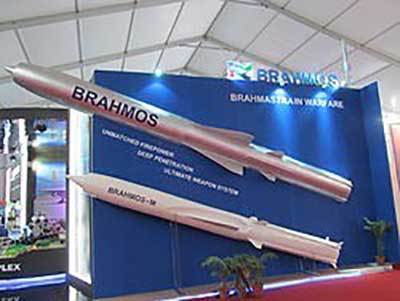Relevance: GS-3: Achievements of Indians in science & technology; indigenization of technology and developing new technology.
Key phrases: BrahMos, cruise missile, DRDO, Russia, supersonic, medium range, MTCR.
Why in News?
- An extended range sea-to-sea variant of the BrahMos supersonic cruise missile was test fired on Tuesday from the recently commissioned stealth guided missile destroyer INS Visakhapatnam
What is BrahMos Missile System?
- The BrahMos is a medium-range ramjet supersonic cruise missile that can be launched from submarine, ships, aircraft or land. It is notably one of the fastest supersonic cruise missiles in the world.
- It is a joint venture between the Russian Federation's NPO and India's Defence Research and Development Organisation (DRDO), who together have formed BrahMos Aerospace.
- It is based on the Russian P-800 Oniks cruise missile and other similar sea-skimming Russian cruise missile technology.
- The name BrahMos is a portmanteau formed from the names of two rivers, the Brahmaputra of India and the Moskva of Russia.
Cruise Missile vs. Ballistic Missile
- Cruise missile is a guided missile (target has to be pre-set) used against terrestrial targets where as a ballistic missile follows a ballistic trajectory to deliver one or more warheads on a predetermined target.
- Cruise missile remains in the atmosphere throughout its flight whereas Shorter range ballistic missiles stay within the Earth’s atmosphere but Longer-ranged intercontinental ballistic missiles (ICBMs) are launched on a sub-orbital flight trajectory and spend most of their flight out of the atmosphere.
- The trajectory of cruise missile is fully determined by its propulsion system where as the trajectory of ballistic missile is fully determined by a given initial velocity, effects of gravity, air resistance, and motion of the earth (Coriolis Force).
- Cruise missile has active propulsion during its flight where as a ballistic missile has no active propulsion during its actual flight.
- Cruise missile is low, hard to detect them on radar where as a ballistic missile is easily detectable on radar.
Missiles in BrahMos Missile System:
BrahMos I:
- This is the first supersonic cruise missile to enter service in India.
- The BrahMos missile has a maximum speed of 2.8 Mach and is difficult to intercept by surface-to-air missiles currently deployed from warships across the world. It also has immense ability to evade various radars.
- The missile’s cruising altitude could be up to 15 km, and the lowest it can fly is 10 metres above the surface. The missile is capable of carrying a conventional warhead (non-nuclear) weighing 200-300 kg.
- The BrahMos is a two-stage missile, with a solid propellant booster engine that kicks in in the first stage and brings the missile to supersonic speed before separating.
BrahMos-II or BrahMos-2 or BrahMos Mark II:
- It is a hypersonic cruise missile currently under joint development by India's DRDO and Russia's NPO, which have together formed BrahMos Aerospace Private Limited.
- It is the second of the BrahMos series of cruise missiles. The BrahMos-II is expected to have a range of 1,000 kilometres and a speed of Mach 8.
Extended range Brahmos:
- In 2016, India got the membership of MTCR, and India and Russia have now agreed to jointly develop the next generation Brahmos missiles with 600 km plus range.
- In March 2017, the Brahmos Cruise missile with 450 km range was successfully test fired from the Integrated Test Range, Odisha. This range extension required only a software change.
Missile Technology Control Regime
- The Missile Technology Control Regime (MTCR) is a multilateral export control regime.
- It is an informal political understanding among 35 member states that seek to limit the proliferation of missiles and missile technology.
- The regime was formed in 1987 by the G-7 industrialized countries.
- It controls the export of the technologies and materials involved in ballistic missile systems and unmanned aerial vehicles particularly capable of carrying nuclear warheads of above 500kg payload for more than 300 km.
Significance of Cruise Missile for India:
- Increases India defence export: Many South East Asian and Latin American countries have expressed their interest in acquiring the Brahmos Missile system. Countries like Philippines, Vietnam, Egypt, Indonesia, Malaysia, Oman, Chile, Brazil, Venezuela etc., have shown interest in naval and coastal defence versions of Brahmos missile.
- Strategic importance to India: The world’s fastest anti-ship cruise missile, BrahMos is a part of the arsenal of all three arms of the Indian defence forces - Army, Navy, and Air Force. Several versions of BrahMos exist which can be fired from land, from water via warships and submarines and from air via the Sukhoi-30 fighter jets.
- Increase defence capabilities and deterrence to enemy: Brahmos acts as a credible deterrence against China and Pakistan as they do not have cruise missiles with similar capabilities. The opposition of China on the deployment of Brahmos missiles in Arunachal Pradesh in 2016 proves its effectiveness.
- Expanding India’s Geopolitical Horizons: The BrahMos export will boost India’s economic, soft, and hard power profile in the region and provide the Indo-Pacific with a strong and dependable anchor with which they can protect their sovereignty and territory.
Source: The Hindu
Mains Question:
Q. How is BrahMos Cruise Missile system technically superior to any other system present available in the world? Discuss its strategic importance for India.
UPSC CSE MAIN 2021 GS-3 PAPER









